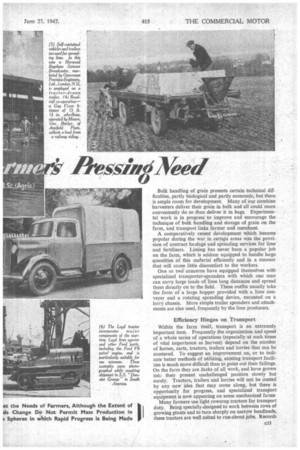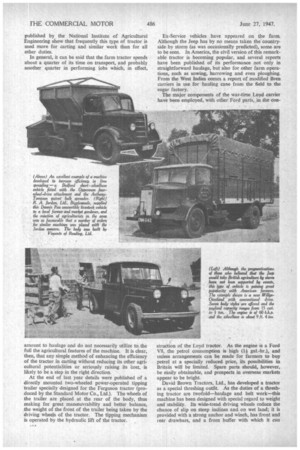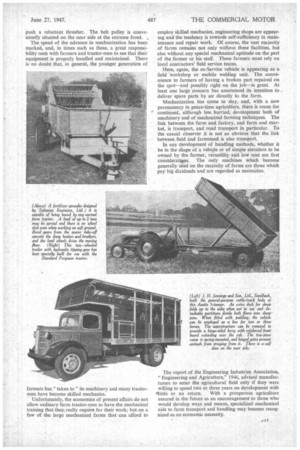THAN SPOUT taw
Page 50

Page 51

Page 52

Page 53

If you've noticed an error in this article please click here to report it so we can fix it.
AesisinhiNed
AN active countryside is a big market for industry, and during the war (to take one sphere of activity as an example) a " new " agricultural engineering sprang up. Large and small concerns entered the agricultural field and joined farmers and crop husbandry experts not only in developing conventional types of equipment, but also in producing entirely new machines, some being designed to handle jobs that had never pre
viously been mechanized. In this work they were encouraged to co-operate with the National Institute of Agricultural Engineering, which was set up by the Ministry of Agriculture in 1942 to act as a centre of information and to carry out practical tests and research work.
Unfortunately, the home market for large-scale farm machinery is limited, with the result that sales are relatively small and costs are high, Unlike the American market of some 400,000,000 cropped acres. the British home market, even at its war-time peak of about 20,000,000 acres, will not carry the vast manufacturing and distributive organizations that make for Cheap, quick sales and efficient after-sales service.
British Farming Policy Sound The American farmer is probably more amenable to change than the British, and this, too, eases the lot of the manufacturer and salesman. It cannot, however, be over-emphasized that, by its tradition and continuity, British farming has stood the test of time. It is partly because our farmers have not been swayed to extremes by recurring opportunities of cash-cropping, that, after generations, we still have a fertile soil.
The economic, climatic and social aspects of any agriculture are so inexorably bound together that comparison of home with overseas conditions and techniques seldom leads anywhere, but agriculture, the world over, is a great user of transport in one form or another. Cattle trucks and horseboxes have long been a common sight on our roads. Wintry lanes have been congested by high-Sided lorries and tractors and trailers carrying, in the form of sugar beet, a large part of the civilian sugar ration to the factories for processing. New spheres are now opening up for transport.
Bulk handling of grain presents certain technical difficulties, partly biological and partly economic, but there is ample room for development. Many of our combine harvesters deliver their grain in bulk and all could more conveniently do so than deliver it in bags. Experimental work is in progress to improve and encourage the technique of bulk handling and storage of grain on the farm, and transport links farmer and merchant.
A comparatively recent development which became popular during the war in certain areas was the provision of contract haulage and spreading services for lime and fertilizers. Liming has never been a popular job on the farm, which is seldom equipped to handle large quantities of this material efficiently and in a manner that will cause little discomfort to the workers.
One or twO concerns have equipped themselves with specialized transporter-spreaders with which one man can carry large loads of lime long distances and spread them directly on to the field. These outfits usually take the form of a large hopper provided with a lime conveyer and a rotating spreading device, mounted on a lorry chassis. More simple trailer spreaders and attachments are also used, frequently by the lime producers.
Efficiency Hinges on Transport Within the farm itself, transport is an extremely important item. Frequently the organization and speed of a whole series of operations (especially at such times of vital importance as harvest) depend on the number of horses, carts, tractors, trailers and lorries that can be mustered. To suggest an improvement on, or to indicate better methods of utilizing, existing transport facilities is much more difficult than to point out their failings. On the farm they are Jacks of all work, and have grown into their present unchallenged position slowly but surely. Tractors, trailers and lorries will not be ousted by any new idea that may come along, but there is opportunity for progress, and specialized transport equipment is now appearing on some mechanized farms Many farmers use light rowcrop tractors for transport duty. Being specially .designed to work between rows of growing plants and to turn sharply on narrow headlands, these tractors are well suited to run-about jobs. Records published by the National Institute of Agricultural Engineering show that frequently this type of tractor is used more for carting and similar work than for all other duties.
In general, it can be said that the farm tractor spends about a quarter of its time on transport, and probably another quarter in performing jobs which, in effect, amount to haulage and do not necessarily utilize to the full the agricultural features of the machine. It is clear, then, that any simple method of enhancing the efficiency of the tractor in carting without reducing its other agricultural potentialities or seriously raising its cost, is likely to be a step in the right direction.
At the end of last year details were published of a directly mounted two-wheeled power-operated tipping trailer specially designed for the Ferguson tractor (produced by the Standard Motor Co., Ltd.). The wheels of the trailer are placed at the rear of the body, thus making for great manceuvrability and better balance, the weight of the front of the trailer being taken by the driving wheels of the tractor. The tipping mechanism is operated by the hydraulic lift of the tractor. Ex-Service vehicles have appeared on the farm. Although the Jeep has by no means taken the countryside by storm (as was occasionally predicted), some are to be seen. In America, the civil version of this remarkable tractor is becoming popular, and several reports have been published of its performance not only in straightforward haulage, but also for other farm operations, such as sowing, harrowing and even ploughing. From the West Indies comes a report of modified Bren carriers in use for hauling cane from the field to the sugar factory.
The major components of the war-time Loyd carrier have been employed, with other Ford parts, in the con struction of the Loyd tractor._ As the engine is a Ford VS, the petrol consumption is high (li gal.-hr.), and unless arrangements can be made for farmers to buy petrol at a specially reduced price, its possibilities in Britain will be limited. Spare parts should, however, be easily obtainable, and prospects in overseas markets appear to be bright.
David Brown Tractors, Ltd., has developed a tractor as a special threshing outfit. As the duties of a threshing tractor are twofold—haulage and belt work—this machine has been designed with special regard to weight and stability. Its wide-tread driving wheels reduce the chance of slip on steep inclines and on wet land; it is provided with a strong anchor and winch, has front and rear drawbars, and a front buffer with which it can push a reluctant thresher. The belt pulley is conveniently situated on the near side at the extreme front.
The speed of the advance in mechanization has been marked, and, in times such as these, a great rcsponsibility rests with farmers and tractor-men to see that their equipment is properly handled and maintained. There is no doubt that, in general, the younger generation of
farmers has "taken to" its machinery and many tractormen have become skilled mechanics.
Unfortunately, the economics of present affairs do not allow ordinary farm tractor-men to have the mechanical training that they, really require for their work; but on a few of the large mechanized farms that can afford to employ skilled mechanics, engineering shops are appearing and the tendency is towards self-sufficiency in maintenance and repair work. Of. course, the vast majority of farms remains not only without these facilities, but also without any special mechanical aptitude on the part of the farmer or his staff. These farmers must rely on local contractors' field service teams.
Here, again, the ex-Service vehicle is appearing as a field workshop or mobile welding unit. The convenience to farmers of having a broken part repaired on the spot—and possibly right on the job—is great. At least one large concern has announced its intention to . deliver spare parts by air directly to the farm.
Mechanization has come to Stay, and, with a new permanency in peace-time agriculture, there is room for I continued, although less hurried, development both of machinery and of mechanized farming techniques. The link between the farm and factory, and farrn and market, is transport, and road transport in particular. To the casual observer it is not so obvious that the link between field and farmstead is also transport.
In any development of handling methods, whether it be in the shape of a vehicle or of simple elevators to be owned by the farmer, versatility and low cost are first considerations. The only machines which become generally used on the majority of farms are those which pay big dividends and are regarded as necessities.
The report of the Engineering Industries Association, "Engineering and Agriculture," 1946, advised manufacturers to enter the agricultural field only if they were willing to spend two or three years on development with glittle or no return. With a prosperous agriculture assured in the future as an encouragement to those who would develop ways and means, specialized mechanical aids to farm transport and handling may become recognized as an economic necessity.




































































































